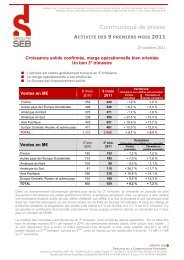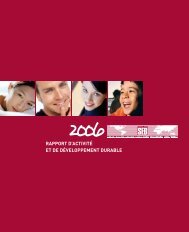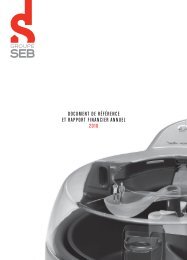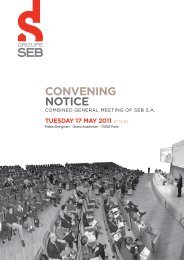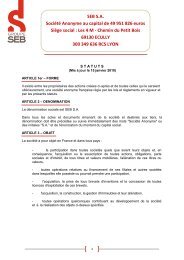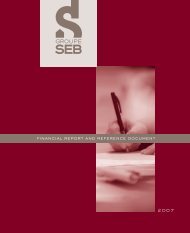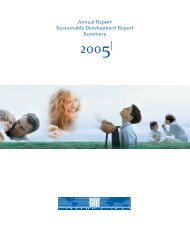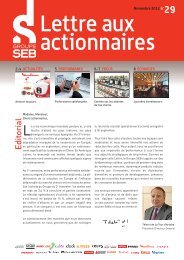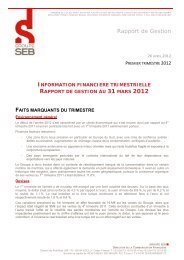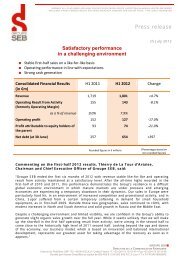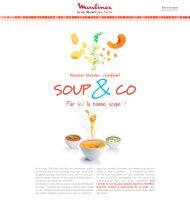financial report and registration document 2011 - Groupe SEB
financial report and registration document 2011 - Groupe SEB
financial report and registration document 2011 - Groupe SEB
You also want an ePaper? Increase the reach of your titles
YUMPU automatically turns print PDFs into web optimized ePapers that Google loves.
In <strong>2011</strong>, with only a few rare exceptions, the Group’s manufacturing facilities<br />
operated normally, with full absorption of fi xed production costs. Specifi c,<br />
targeted measures were taken on sites where capacity utilisation was lower.<br />
The Group’s industrial competitiveness comes from its edge as a designer<br />
of products, especially through its centres of expertise <strong>and</strong> technological<br />
centres:<br />
� product expertise centres bring together the specifi c expertise in research<br />
<strong>and</strong> development, industrialisation <strong>and</strong> production for a given product<br />
category;<br />
� technological centres reinforce product expertise centres through their<br />
knowledge of key technologies in relation to materials, plastics, <strong>and</strong><br />
electronics.<br />
At relevant sites, project platforms foster collaboration between marketing<br />
teams <strong>and</strong> centres of industrial expertise in the development of product<br />
offerings.<br />
To ensure <strong>and</strong> optimise the competitiveness of its industrial capacity, the<br />
Group constantly upgrades its plants, taking into account the economic<br />
reality of markets: adjustment of production volumes, relocation of h<strong>and</strong>mixers<br />
production to the Mayenne site, strict control of manufacturing costs,<br />
refocusing of production <strong>and</strong> greater use of outsourcing, according to needs.<br />
An ambitious operational excellence programme was launched in France<br />
in <strong>2011</strong>. It aims to optimise operations at production sites through the<br />
collaboration of all employees. This programme is due to be deployed<br />
outside of France in early 2012. Similar actions were carried out within Supor<br />
<strong>and</strong> by the <strong>SEB</strong> Asia teams with regard to Chinese subcontractors.<br />
Purchasing<br />
Purchasing covers requirements for materials (metals, plastics, paper/<br />
cardboard packaging, etc.) <strong>and</strong> components (parts, sub-systems, etc.)<br />
for industry, non-production purchasing (transport <strong>and</strong> logistics, services,<br />
information systems, travel, etc.) <strong>and</strong> purchases of sourced finished<br />
products. Purchases are increasingly managed at Group level, to provide<br />
optimum negotiation conditions, not only in terms of pricing, but also in terms<br />
of quality, on-time delivery, etc. For several years now, production purchases<br />
have benefi ted from a centralised organisation tailored to each project <strong>and</strong><br />
each contract. In <strong>2011</strong>, for production purchases, the Group had a panel of<br />
365 suppliers representing approximately 88% of global purchasing.<br />
Non-production purchases currently follow the same process aimed at<br />
better qualifying approved suppliers <strong>and</strong> building an across-the-board Group<br />
purchasing methodology with a panel of approved suppliers (600 at yearend<br />
<strong>2011</strong>). To this end, the team was signifi cantly reinforced, increasing<br />
from 15 to 26 people with the aim of covering a much wider spectrum of<br />
expenditures <strong>and</strong> a broader international scope (integration of Russia <strong>and</strong><br />
greater coverage in Colombia).<br />
Financial Report <strong>and</strong> Registration Document <strong>2011</strong><br />
1<br />
Presentation of the Group<br />
Group strategy<br />
The Group’s industrial competitive edge is also the result of manufacturing<br />
capacity upgrades to meet increasingly high dem<strong>and</strong>, as it is currently the<br />
case in China. Expansion of the Wuhan site (Supor), dedicated to cookware,<br />
was completed in <strong>2011</strong>. This greatly increased production capacities.<br />
Upgrades to the Shaoxing plant, built in 2009, were driven by the launch of<br />
new electrical appliance categories. The Group thus re-integrated a portion<br />
of its production (including electric kettle production) that had previously<br />
been outsourced to Chinese subcontractors. In a similar effort to respond<br />
to booming local dem<strong>and</strong>, the Group now has an industrial presence in<br />
Vietnam, with a Supor plant that is gradually ramping up, as well as the<br />
Asia Fan production facilities, which supplement the Group’s non-culinary<br />
product business.<br />
At the same time, the Group strives constantly to improve employee safety<br />
in the workplace. In this regard, a three-year plan has been launched, aiming<br />
for a steady decrease in the number of workplace accidents.<br />
Three to four years ago, the Group also introduced a global Supply<br />
Chain Management system intended to rationalise stocks of finished<br />
products, optimise the quality of these stocks <strong>and</strong> implement a process to<br />
improve customer service. The actions undertaken resulted in signifi cant<br />
improvements in the ratios with, in particular, a clear improvement in the<br />
inventories of low turnover products, a major reduction in supply chain<br />
costs (transport <strong>and</strong> warehousing) <strong>and</strong> major progress in sales forecasts.<br />
Results vary from continent to continent, however, <strong>and</strong> the Group continues<br />
its efforts to bring all markets into line with these stricter st<strong>and</strong>ards.<br />
For purchases of sourced fi nished products, in 2010 the Group introduced<br />
a Group Finished Products Purchasing department, created a Finished<br />
Products Purchasing function in operations <strong>and</strong> strengthened its dedicated<br />
teams within its <strong>SEB</strong> Asia subsidiary in Hong Kong. This reorganisation has<br />
helped to strengthen purchasing quality processes for fi nished products<br />
by guaranteeing technical <strong>and</strong> methodological assistance for Group teams<br />
with suppliers. At the same time, it demonstrates the Group’s desire to<br />
integrate suppliers upstream in the product development process in order<br />
to foster greater fl uidity in creating products. Through this approach, the<br />
Group was able to obtain a more concentrated panel of approved fi nished<br />
product suppliers, which, at year-end <strong>2011</strong>, comprised around 50 companies<br />
representing 78% of purchases made.<br />
The Group’s approved supplier panels consist of carefully selected <strong>and</strong> tested<br />
companies in terms of both performance (lead times, quality, cost, etc.) <strong>and</strong><br />
social <strong>and</strong> environmental responsibilities (environmental impact, compliance<br />
with Human Rights, etc.).<br />
GROUPE <strong>SEB</strong><br />
1<br />
11



